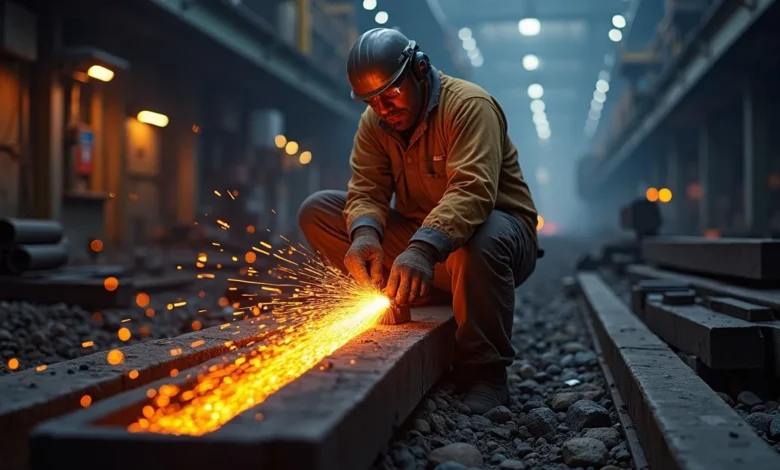EU Steel Tariffs Explained Simply

Steel is like the backbone of many things we use every day. Think cars, buildings, and even cans for food. But sometimes, countries add extra costs on steel coming from outside. These are called tariffs. In Europe, the group of countries called the European Union, or EU, uses these to help their own steel makers. EU steel tariffs make foreign steel more expensive. This protects jobs and factories inside the EU.
Right now, in 2025, the EU is changing these rules. They want to cut how much steel can come in without extra costs. They also plan to double the tariff to 50% on extra steel. Why? Cheap steel from places like China floods the market. This hurts EU workers. The European Commission leads this. They say it’s to fight unfair trade.
This matters because steel touches global trade. It affects prices for everyone. We’ll look at how these tariffs work, their effects, and what’s next. Stick around to learn more.
What Are EU Steel Tariffs?
EU steel tariffs are extra fees on steel brought into Europe from other countries. They started years ago to shield local factories. Imagine a wall that makes outside steel cost more. This helps EU companies sell their steel easier.
The tariffs began in 2018. Back then, the US added its own fees on steel. This pushed extra steel toward Europe. So, the EU set up safeguards. These are rules with limits on imports. If too much comes in, tariffs kick in.
Today, EU steel tariffs include quotas. Quotas are like caps on free imports. For 26 types of steel, there’s a set amount that enters without tariffs. Above that, it’s 25% extra cost. But now, the EU wants to change this. They propose cutting quotas by 47%. That means only 18.3 million tons come free each year. Extra gets 50% tariff.
This isn’t just any change. It’s to match US levels and push for talks. The European Commission says it protects 300,000 jobs. Steel makers like it. But importers worry about higher prices.
How Do These Tariffs Fit into EU Trade Policies?
EU trade policies focus on fair play. Tariffs are part of that. They use anti-dumping tariffs too. These target cheap steel sold below cost. For example, from China or India.
The World Trade Organization, or WTO, watches this. They make sure rules are followed. EU steel tariffs follow WTO guidelines. But disputes happen. Countries can challenge them.
Why Does the EU Use Steel Tariffs?
The EU uses steel tariffs to protect its industry. Global overcapacity is a big reason. That means too much steel is made worldwide. China makes over half the world’s steel. They sell it cheap. This undercuts EU prices.
Without tariffs, EU factories close. Jobs vanish. In recent years, EU steel output dropped. Imports rose. So, tariffs balance this. They make foreign steel less cheap.
Another reason is trade wars. In 2018, US tariffs started a chain. The EU responded with its own. It was retaliation. Now, it’s about stability. The EU wants market stability in the steel sector.
European steel producers cheer this. Groups like Eurofer say it’s vital. They represent makers across Europe. Tariffs help competitiveness. But critics say it raises costs for everyone.
Key Reasons Behind EU Steel Industry Protection
Protection comes from history. Brexit changed things too. UK steel now faces EU rules like outsiders. This adds pressure. Also, green goals matter. The EU pushes clean steel. Tariffs support that shift.
Statistics show impact. EU steel imports hit records in 2024. Production fell 10%. Tariffs aim to reverse this.
How Do EU Steel Tariffs Work?
EU steel tariffs work like a system with steps. First, there’s a quota. This is the free import limit. Based on past averages from 2015-2017, plus a bit more.
For each steel type, countries get shares. Like hot-rolled coils or plates. If a country fills its share, others can use leftovers. But overall, excess pays tariff.
Now, the update: Quotas drop to 18.3 million tons yearly. That’s half of what it was before. Tariff jumps to 50%. This starts mid-2026 if approved.
Exemptions exist. Ukraine gets a pass due to war. But the UK and Switzerland don’t. The EU reviews this often. They adjust for changes.
Importers track this via systems. They declare steel at borders. Customs add fees if over quota.
Understanding EU Steel Quotas and Duties
Quotas split by country and product. For example, China has limits on certain grades. Duties are import taxes. Anti-dumping adds more. Up to 35% on some Chinese steel.
This quota system is the import quota system. It manages supply and demand.
Impact of EU Steel Tariffs on Manufacturers
EU steel tariffs affect manufacturers in big ways. Local steel makers benefit. They face less cheap competition. This saves jobs. About 300,000 people work in EU steel.
But downstream users suffer. These are companies using steel, like car makers or builders. Higher import costs mean pricier steel. This raises product prices.
For example, German car firms worry. They say tariffs add billions in costs. Small manufacturers hit hardest. They can’t absorb fees easily.
Global exporters feel pain too. China, India, Turkey send less. Their factories slow. This shifts trade flows.
However, some adapt. They build EU plants. Or find new markets. Tariffs push innovation too. Like better, greener steel.
Real-World Examples of Tariff Effects
Take the UK. Post-Brexit, EU steel tariffs threaten their industry. Unions call it catastrophic. The UK exports 60% of steel to the EU. The new 50% tariff could close plants.
In the US, similar tariffs raised prices 25%. Manufacturers there complained. But jobs grew in steel.
Statistics: EU steel prices up 20% since tariffs. Imports down 15%.
EU vs US Steel Tariffs: A Comparison
EU and US steel tariffs share roots but differ. Both started in 2018. The US used Section 232 for security. 25% on steel imports.
The EU responded with safeguards. Not direct tariffs, but quotas with fees. The US hit the EU hard. Then, the 2021 deal eased it. Tariff-rate quotas let some EU steel in free.
Now, in 2025, the EU matches the US at 50% on excess. This is to negotiate. The US keeps 25% base, but deals vary.
Differences: US focuses on security. EU on overcapacity. US tariffs are broader. EU more targeted.
Both face WTO challenges. China sued both.
How Do They Stack Up?
| Aspect | EU Steel Tariffs | US Steel Tariffs |
| Base Rate | 25% to 50% on excess | 25% general |
| Quotas | 18.3M tons free | TRQ with EU |
| Focus | Overcapacity, China | National security |
| Exemptions | Ukraine | Some allies |
| Impact on Trade | Reduces imports 47% | Raised prices 25% |
This table shows key differences. The EU leans on quotas more.
The Future of EU Steel Tariffs Post-2025
Looking ahead, EU steel tariffs might tighten more. The proposal goes to vote. If passed, starts June 2026. Reviews every year.
Big factor: US elections. If Trump wins, tariffs rise. The EU uses 50% as a bid for talks. Aim: Remove US fees on EU steel.
Carbon border adjustment mechanism, or CBAM, adds layers. From 2026, it taxes carbon in imports. Steel included. This could replace some tariffs.
WTO role grows. Disputes may force changes. The EU wants fair resolution.
Predictions: Tariffs stay if overcapacity persists. But green trade could ease them.
What Changes Might Come?
Experts say negotiations key. EU-US steel tariff agreement could expand. Watch for retaliation from China.
Long-term: EU aims for self-sufficiency. Investments in clean steel rise.
Global Effects of EU Steel Trade Restrictions
EU steel tariffs ripple worldwide. The global steel trade war heats up. Exporters like China face barriers. They dump elsewhere, hurting others.
Trade deficit in steel grows for some. EU imports less, so prices rise globally.
However, it pushes fair trade. Countries negotiate better deals.
Brexit and EU steel trade: UK suffers most. No inside perks.
Impact on European manufacturers: Mixed. Protection vs. costs.
Overall, tariffs shape supply chains. Companies diversify sources.
Case Study: China’s Response
China retaliated before. With pork tariffs on the EU. More could come. This affects farmers too.
In conclusion, EU steel tariffs protect but challenge. They balance local needs with global ties. If you’re in business, watch updates. Check European Commission sites for news. What do you think about these changes? Share below.
FAQs
What are the current EU steel import restrictions?
Right now, EU steel tariffs allow quotas for free imports. Above that, 25% duty. But plans cut quotas 47% and raised them to 50%. This manages cheap floods.
How do EU steel tariffs affect global trade?
They reduce imports, raising prices. Exporters lose markets. It sparks talks but can start retaliations, like from China.
Are EU steel tariffs hurting manufacturers?
Yes, for some. Importers pay more. But local steel firms gain. Overall, it protects jobs but hikes costs for cars and buildings.
The role of WTO in EU steel tariff disputes?
WTO ensures fair rules. Countries challenge tariffs there. The EU follows WTO, but disputes happen over dumping.
How EU steel tariffs influence steel prices?
They push prices up in the EU. Less cheap imports mean local steel costs more. Globally, it shifts supplies.
Key Citations
- European Commission: Proposal on steel safeguards, October 2025. https://policy.trade.ec.europa.eu/news/commission-proposes-new-safeguard-measures-steel-imports-2025-10-07_en
- Reuters: EU to halve steel import quotas. https://www.reuters.com/world/china/eu-halve-steel-import-quotas-revive-domestic-industry-2025-10-07/
- Politico: EU sets 50% steel tariff. https://www.politico.eu/article/eu-set-50-percent-steel-tariff-opening-bid-donald-trump/
- BBC: EU tariff hike threatens UK industry. https://www.bbc.com/news/articles/cwy875px79po
- The Guardian: Existential threat to UK steel. https://www.theguardian.com/business/2025/oct/07/eu-plan-to-match-trump-steel-tariffs-spurs-existential-threat-to-uk-steel-industry
- Eurofer: New trade measures. https://www.eurofer.eu/press-releases/new-trade-measure-is-major-leap-forward-to-save-eu-steel-and-hundreds-of-thousands-of-jobs-now-fast-track-adoption-is-crucial-says-eurofer
- White House: US-EU trade deal fact sheet. https://www.whitehouse.gov/fact-sheets/2025/07/fact-sheet-the-united-states-and-european-union-reach-massive-trade-deal/
- S&P Global: EU extends safeguards. https://www.spglobal.com/commodity-insights/en/news-research/latest-news/metals/061121-eu-extends-steel-safeguards-another-three-years

